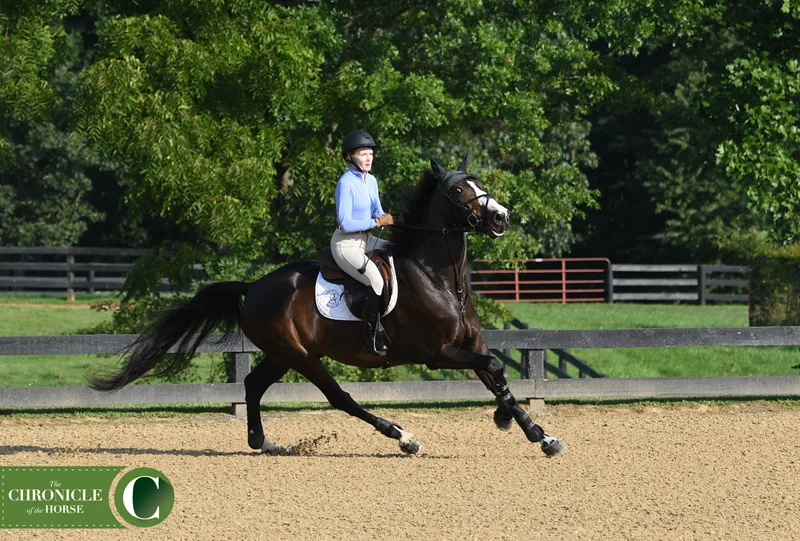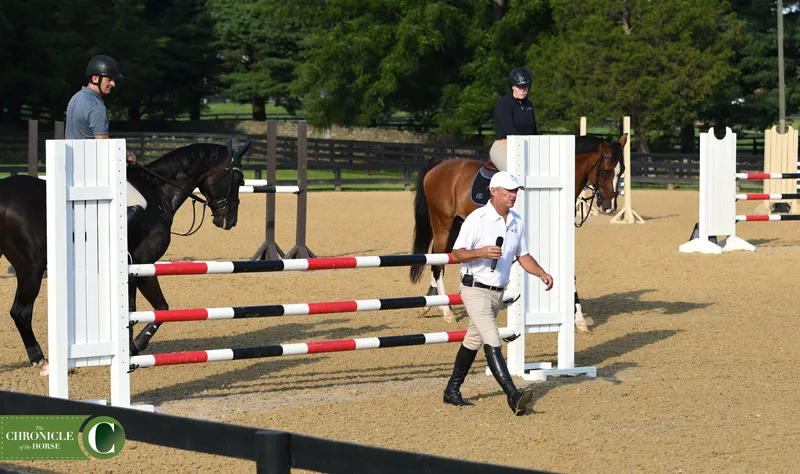Middleburg, Va.—Aug. 8
As Will Simpson said, “There’s never been a perfect round.” Things always pop up—whether it’s just a little head toss that got the horse a shade closer to the fence than anticipated or a spook that leads to a full-on stop. But what Simpson wanted to highlight in his second day at Rutledge Farm was being adaptable in these situations.
Yesterday, Simpson focused on the horse with gymnastics. He asked riders to do the minimum, while the horses learned to back themselves off the poles and exercises. But today, as he set up a course, the goal was to simulate a competition ride. And in that competition ride, the focus was on the riders and how they coped in different situations; how to turn a 4- or 8-fault round into a clear.
“A schooling ride, which we did yesterday, was all to the base, drop the horse, no hand, lots of leg, push the horse and the horse gathers itself, mind its footfall pattern, and jump because of the rail,” explained Simpson. “And then today, it’s more of a competitive ride where you want to do everything in your power to keep that rail up.”
He asked the three riders, Gavin Moylan, Amanda Smith and Kate Paige, to warm up on the flat and then when ready, canter over four rails set at a tight one-stride to a three-stride to a four-stride. Then they warmed up over a vertical and an oxer before really getting down to business.
Moylan took the first stab at the course with his green 8-year-old Balous Diamond. The Westphalian stallion showed immense scope and talent, but when he got to the skinny at fence 7, the horse lowered his head and spooked. And here with a green horse, Simpson emphasized straightness and riding from seat to hand, especially since perfection is rare at that stage.
“In that situation, he got a little confused,” said Simpson. “He was late with his eye. He was a little bit down, and he was late with his eye, and all of a sudden he got there, and it was a good distance, but he said, ‘Hey wait a minute. Where did that come from?’
“Get his head up, but you can’t do that with just your hand,” Simpson continued. “In order to get a horse’s head up you’ve got to use your seat, your leg, and ride the horse up with your seat and your leg into your hand. If you try to do it with just your hands, he’s just going to go down lower, and it’s just not going to work.
ADVERTISEMENT
“And then, your goal, especially with a skinny or a fence on the end, is to get on that straight line and don’t let [the horse] deviate from it,” Simpson explained. “All it is is about three inches. If he gets three inches from the side that means that door is wide open. Make a pinpoint, not just in between those two standards, but you want to jump the middle of that rail—a little dot on the middle of that rail.”
With straightness and blocking the sides, Simpson said, horses find it easier to jump the fence instead of stopping at it. And after the initial bobble, Balous Diamond jumped fantastically the rest of the clinic.
“All the green horses I’ve ever ridden, they come down, and they say, ‘Oh I want to go right.’ You say, ‘No.’ ‘I’d rather go left.’ You say, ‘No.’ They say, ‘Well I might as well jump it even though it’s a scary jump,’ ” Simpson explained. “So if you can stay on that straight line they’ll usually end up jumping.”

Galvin Moylan and Balous Diamond conquered the skinny coop after Moylan focused on bringing his horse’s head up with his leg and seat. Photo by Laura Lemon.
With Smith on Dealbreaker and Paige on Kirin, it was more about finesse with their made horses to eliminate the unlucky rail.
Paige’s gelding kept building and building in energy. To solve the issue, Simpson first had her canter alongside the first diagonal line and roll back and just jump fence 4.
“Think about staying in the middle of your horse and what I call correctness of riding,” said Simpson. “Just a look down the four-stride and look to the right. And try not to send her forward with your leg or your seat. And then just steer the horse and then down to trot a little bit. Just say, ‘Whoa. Relax.’ And see if you can get all the way around that turn with your hands low and very little adjustments. Because the adjustments are magnified with this horse.”
He then had her jump fence 9 and halt before fence 8 when they jumped the course in the opposite direction. But then Simpson wanted to break it down even more with flatwork towards a walk transition.

Kate Paige and Kirin worked on their rideability and staying relaxed in between the jumps. Photo by Laura Lemon.
“When you bring your horse down in the downward transition, what’s your method when you go from the canter to the walk?” asked Simpson. “I want you try a four-step method. So you’ll be cantering along, and then I want you to stretch up a little and then sink down on the saddle, and close your leg and close your fingers.”
ADVERTISEMENT
After practicing going from a canter to a walk several times, they attempted the line again, first halting and then riding through. The final time Kirin was more relaxed and didn’t tick a rail.
“It’s like the chicken and the egg, which one started first? He thinks you’re busy, and you think he’s busy. We’re the leader, and the horse is the follower,” said Simpson. “This horse does what I call rambling on in the course. Starts off pretty good, and then everything starts to light up. But the rider has to be more tranquil. You have to be the tranquil force in the mix. So if you can figure out how you had the confidence to stop in here, you should be able to have the confidence to gather your horse, keep him round, and then you participate in helping stay off the rails.”

Will Simpson had Kate Paige halt in the middle of a line to work on transitions and getting the horse back through its hind end. Photo by Laura Lemon.
For Smith and Dealbreaker, their issues came with the heat and the pressure of yesterday’s gymnastics. The distances were all correct, and the rides smooth, but through the courses, they started to pick up a few careless rails. Simpson talked about reading each situation and what each horse needs at a given fence. By the end of the lesson, Dealbreaker needed more space before the jumps.
“Distances were a little snug and a little bit trapped by the jump,” said Simpson. “It’s been a couple of grueling days, with a lot of gymnastics yesterday and with the heat yesterday. It’s a little bit much. So you want to know your horse. A little bit of room here, so it’s not so deep. And the horses change; in the beginning when they’re fresh, you can get a little deeper.”
With Smith finishing off the same reverse line as Paige, she gave Dealbreaker more room, and he jumped clear.

Amanda Smith had to listen to Dealbreaker to figure out the distance that he wanted at a given moment. Photo by Laura Lemon.
“That’s the fun thing about partnering with an animal for sport, they’re always changing. They get tired, and they get fresh,” said Simpson. “So yesterday was completely different: all leg no hand, deep to the base, really get the horse so they’re really afraid to touch the rails. Then today, a show ring ride, you get to know your horse and horses. It’s the fun part about horses—sometimes they’re fresh at the beginning of the course, and then they’re tired at the end. Or sometimes they’re building so much at the end of the course that you’ve got twice the horse you had at the beginning. So we have to always adapt as to what kind of distance we want to use. Sometimes the horse needs to go right to the base. Sometimes they need a little more room. So the rider, you want to feel that, what’s going on underneath you.
“In schooling, we want to teach the horse how to change forward motion to up and down and really come off the floor and jump in the air. So we’re trying to emphasize that in training,” continued Simpson. “Then when you get on course, it’s an art. It’s an art basically to know what kind of jump a horse needs. Sometime you have to come out of the corner and have a bold fence and get them going, and other times you want to hold and get them to the base. You can actually keep a horse fresh as you’re going around a course of jumps, but you have to know what your horse is thinking and if he’s getting too flat, is he getting too forward, is he hanging up? It’s an art form to the different kind of jumps a horse needs to get further on the course.”

















